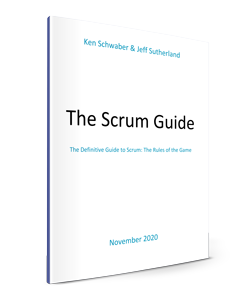The new version of the Scrum Guide has just been released. It is exciting! Scrum walks the talk by inspecting and adapting itself. So should you as a Scrum Master. In this article, I’ll talk about how new Scrum Guide changes affect you and what you need to do now.

Need help understanding how to apply the Scrum Guide?
Get the Scrum Master Startup Guide that will give you all the key knowledge you need to start as a new Scrum Master in a new team.
This iteration of the guide from November 2020 has a few key changes:
- It is shorter: 14 pages instead of 19 (minus the title page). Because of that the Scrum Guide is less prescriptive, giving you just the outline of the framework and leaving you to decide how to implement it.
- More concise and to-the-point. The key elements and rules of Scrum are no longer hidden in between the lines but are clearly stated in writing. You can’t bypass or skip them anymore. While these rules were actually always part of Scrum, now they have a spotlight in the Scrum Guide.
- It is still Scrum. From the point of view of the key concepts, principles, and values, nothing really changed. As Jeff said it: we didn’t change Scrum, we just described it better (not a quote, just from my memory).
Watch the video to learn more about what you need to focus on now as a Scrum Master after the release of the new Scrum Guide (and no, it’s not “actively do nothing” this time).
To summarize, there are three key aspects I would like to highlight as a result of new changes to the Scrum Guide:
1.
You have to stay up-to-date.
As a Scrum Master, you need to know Scrum – you are the expert after all. It means that you must take your time to read and understand the new Scrum Guide. Take notes of what changed and how it might impact your team and your organization
2.
You work with the whole organization, not just the team.
While this was always the case, now it is crystal clear in the Scrum Guide. You can no longer hide behind your team, you have to work on the organizational level as well. If you are not there yet, it’s a good time to start thinking about how to get there.
Scrum Masters are true leaders who serve the Scrum Team and the larger organization.
Scrum Guide, November 2020
3.
You are an accountable Scrum Master.
Scrum Master role is often misunderstood. Maybe because it did not have clear accountabilities and sounded a bit fluffy. Not anymore.
As a Scrum Master you have a few specific accountabilities to pay attention to: effectiveness and continuous improvement of the Scrum Team, relationships with stakeholders in regards to Scrum, some product activities.
The Scrum Master is accountable for the Scrum Team’s effectiveness.
Scrum Guide, November 2020
You have a lot of work to do, same as before, but now with more clarity.
?
Considering everything you’ve learned from the new Scrum Guide, what are some of the key actions and bold steps you need to take to help yourself, your team, and your organization to be successful with Scrum?
Still confused about Agile and Scrum Master concepts. Join me in the Fundamentals of Agile Online Course.



